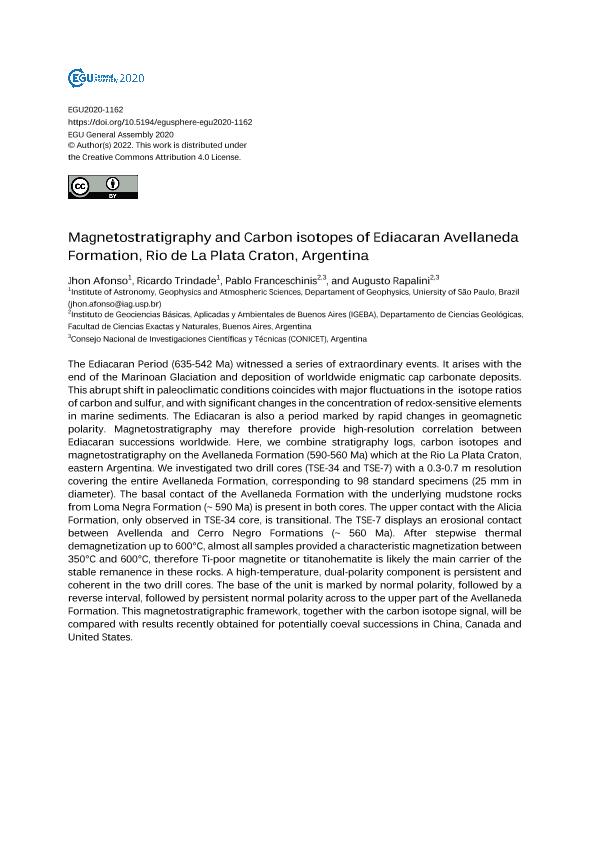Evento
Magnetostratigraphy and Carbon isotopes of Ediacaran Avellaneda Formation, Rio de La Plata Craton, Argentina
Afonso, Jhon; Ferreira Da Trindade, Ricardo Ivan; Franceschinis, Pablo Reinaldo ; Arrouy, Maria Julia
; Arrouy, Maria Julia
 ; Arrouy, Maria Julia
; Arrouy, Maria Julia
Tipo del evento:
Congreso
Nombre del evento:
EGU General Assembly 2020
Fecha del evento:
04/05/2020
Institución Organizadora:
European Geosciences Union;
Título de la revista:
EGU General Assembly 2020
Editorial:
Copernicus Publications
Idioma:
Inglés
Clasificación temática:
Resumen
The Ediacaran Period (635-542 Ma) witnessed a series of extraordinary events. It arises with the end of the Marinoan Glaciation and deposition of worldwide enigmatic cap carbonate deposits. This abrupt shift in paleoclimatic conditions coincides with major fluctuations in the isotope ratios of carbon and sulfur, and with significant changes in the concentration of redox-sensitive elements in marine sediments. The Ediacaran is also a period marked by rapid changes in geomagnetic polarity. Magnetostratigraphy may therefore provide high-resolution correlation between Ediacaran successions worldwide. Here, we combine stratigraphy logs, carbon isotopes and magnetostratigraphy on the Avellaneda Formation (590-560 Ma) which at the Rio La Plata Craton, eastern Argentina. We investigated two drill cores (TSE-34 and TSE-7) with a 0.3-0.7 m resolution covering the entire Avellaneda Formation, corresponding to 98 standard specimens (25 mm in diameter). The basal contact of the Avellaneda Formation with the underlying mudstone rocks from Loma Negra Formation (~ 590 Ma) is present in both cores. The upper contact with the Alicia Formation, only observed in TSE-34 core, is transitional. The TSE-7 displays an erosional contact between Avellenda and Cerro Negro Formations (~ 560 Ma). After stepwise thermal demagnetization up to 600°C, almost all samples provided a characteristic magnetization between 350°C and 600°C, therefore Ti-poor magnetite or titanohematite is likely the main carrier of the stable remanence in these rocks. A high-temperature, dual-polarity component is persistent and coherent in the two drill cores. The base of the unit is marked by normal polarity, followed by a reverse interval, followed by persistent normal polarity across to the upper part of the Avellaneda Formation. This magnetostratigraphic framework, together with the carbon isotope signal, will be compared with results recently obtained for potentially coeval successions in China, Canada and United States.
Palabras clave:
NEOPROTEROZOICO
,
SISTEMA DE TANDILIA
,
PALEOMAGNETIC
,
EDIACARAN
Archivos asociados
Licencia
Identificadores
Colecciones
Eventos(CCT - TANDIL)
Eventos de CTRO CIENTIFICO TECNOLOGICO CONICET - TANDIL
Eventos de CTRO CIENTIFICO TECNOLOGICO CONICET - TANDIL
Eventos(IEGEBA)
Eventos de INSTITUTO DE ECOLOGIA, GENETICA Y EVOLUCION DE BS. AS
Eventos de INSTITUTO DE ECOLOGIA, GENETICA Y EVOLUCION DE BS. AS
Citación
Magnetostratigraphy and Carbon isotopes of Ediacaran Avellaneda Formation, Rio de La Plata Craton, Argentina; EGU General Assembly 2020; Austria; 2020; 1-1
Compartir
Altmétricas



